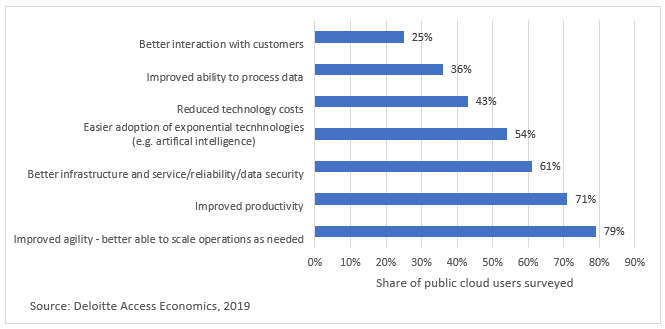What is a private cloud?
Also known as an internal or enterprise cloud it's where Infrastructure resources providing processing capabilities, i.e. compute resources, reside on company’s intranet or hosted data centre. Management of this resource is the responsibility of the company.
This management includes the initial purchase (or rental), installation, maintenance and replacement of all the compute power. The data centre will often supply surrounding firewall protection, whilst the protection of individual resources is the responsibility of the company who commission that resource.
What is the public cloud?
The main differentiator between public and private clouds is that you aren’t responsible for any of the management of a public cloud hosting solution. The commissioning, management, maintenance and security of all resources are the responsibility of the cloud provider.
Like a hosted data centre, physical security and continuous supply of power to the data centre are also the provider’s burden.
There are many opportunities that are created by moving to the public cloud. However, there are also pitfalls that an organisation should prepare themselves for when making the transition.
Opportunities
-
Flexibility
You can commission basic compute resources in minutes. You can also remove resource as quickly. All this assists a business to grow and/or fluctuate their bandwidth demands.
- Cost
This ease of commissioning the compute resource means that an organisation can move from a capital to an operational expenditure model.
- New services
Bring new services online rapidly. From AI and machine learning to the Internet of Things (IoT), organisations can bring these services to their members and customers. And with the flexibility model, these new services can be used for as long, or as short, a duration as is required. - Work anywhere, collaborate everywhere
All you need is an Internet connection. This can improve productivity by providing a great opportunity to work with colleagues, no matter where they are in the global community. - Hardware and system software management
No need to apply and check updates in servers or vulnerabilities that occurred in servers. These updates will be automatically delivered without bringing down any services. This will free up your technical talent to concentrate upon your value-added services, not simply ensuring the lights are on. - Enhanced security
From centralised identity management, to automated continuous business continuity and disaster recovery services - backup, recovery, baked into the services from the ground up. The PRA[1] advice is that “cloud services can significantly improve the operational resilience of individual financial firms”. All the main public cloud providers have extensive defence operation departments, dedicated to working to detect, respond and remediate threats.
[1] Prudential Regulatory Authority's Consultation Paper, "Outsourcing and third-party risk management December 2019"
Pitfalls
-
Staff skills & culture change
Working in the public cloud requires a different skill set in an organisational IT workforce. Pivoting from hardware maintenance to active monitoring and management control of resources is a different way of thinking, and new skills. Automation is a key requirement, especially if you are to extend your IT reach whilst controlling resource cost.
- Technical diversity
The tools available in the public cloud are extensive and growing all the time. Care needs to be taken to actively manage the technical diversity to ensure that that your skills and competencies can cope. Being able to spin up different services in seconds doesn't mean that you should.
- Not a 'lift and shift'
You can simply move the current systems directly to the public cloud. Whilst this will provide some of the benefits (e.g. security), to really take advantage an organisation needs to rethink how it works with technological capability. If it doesn't do this, then it is simply perpetuating the pervious mindset.
- Monitor your expenses
Always, always watch your expenditure. Ensure that you embed commercial awareness into the culture and build in active management of costs, ensuring that your IT team are on top of the expenditure.It's just like electricity; you could leave all the lights on all day, along with the water heating. But, do you need it?When you are not using a resource on the public cloud, you can simply turn it off and will stop paying.
In conclusion
Public Cloud is a powerful resource, with numerous rational reasons to adopt, but be careful. Culture will always beat strategy, so make sure you get that culture right so that you can reap the rewards.

Source: Deloitte Access Economics, 2019

.jpg?width=800&height=533&ext=.jpg)



.png?width=888&height=634&ext=.png)
.png?width=897&height=710&ext=.png)
.jpg?width=200&height=133&ext=.jpg)

.png?width=1950&height=1950&ext=.png)
